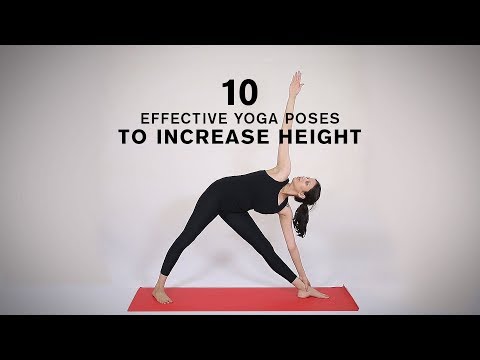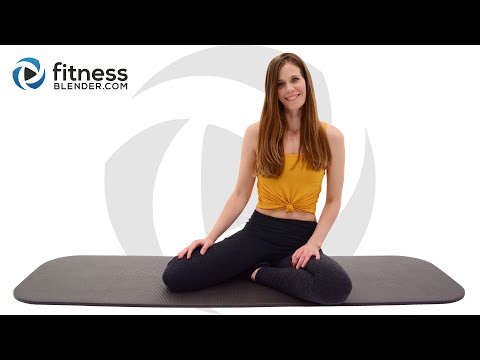
Yoga can make you grow taller by addressing a few key issues. Essentially, yoga stretches your spine, lengthens your back and leg muscles, and improves your posture. It also detoxifies your body, thus spurring the growth of healthy cells.
Here are 10 most effective yoga poses to increase height.
Tadasana – Mountain Pose
Tadasana is a basic standing posture that is a great foundation for many asanas. It creates space in the spine allowing the body to work more efficiently and with more ease.
Vrikshasana – Tree Pose
Vrikshasana or tree pose is a wonderful pose that teaches balance while toning the muscles of the legs. This elegant pose is not as easy as it looks, but over time it builds tremendous inner and outer strength and a great feeling of accomplishment as you learn to balance on one leg.
Uttanasana – Standing Forward Bend
The name Uttanasana (Uth-thA-nA-suh-nuh), known as the Standing Forward bend Pose, is derived from the Sanskrit words Ut (meaning intense), Tan (meaning stretch), and Asana (meaning posture). The end pose leaves in such a position that your head is in a lower stratum than your heart. This enables a gush of blood to the head, revamping the blood cells, leaving you with a sense of novelty.
Adhomukha Svanasana – Downward Facing Dog
Adho Mukha Svanasana posture replicates a dog bending forward, hence the name downward facing dog pose. This asana can be practiced by any beginner too and with all its benefits, one should include it as a part of daily yoga practice. It is a standing pose and mild inversion that builds strength while stretching the whole body.
Trikonasana – Triangle Pose
Triangle Pose is a standing yoga pose that tones the legs, reduces stress, and increases stability. The word “Trikonasana” comes from the Sanskrit words “tri,” (meaning “three”), “kona”(meaning “angle”), and “asana” (meaning “pose”). It refers to the triangular shape created by your body in the full version of the pose. A deep stretch for the hamstrings, groins, and hips, Trikonasana also opens the chest and shoulders. It helps relieve lower back pain, stress, and sluggish digestion.
Utthita Parsvakonasana – Extended Side Angle Pose
Utthita Parsvakonasana pose is a typical beginner-level, standup yoga asana. This pose is particularly responsible to stretch parts of the body that do not typically get strained. This pose is also known as extended flank angle. This asana has its name resulting from the Sanskrit word ‘Utthita’ that means ‘extended’, ‘Parsva’ means ‘ side’, ‘kona’ means ‘angle’ and ‘asana’ means ‘posture’ or ‘pose’. This pose is also benefits your body to get familiar to extending and twisting.
Bhujangasana – Cobra Pose
The name comes from the Sanskrit words bhujanga meaning ‘snake’ or ‘serpent’ and asana meaning ‘posture’ or ‘seat’. From a prone position with palms and legs on the floor, the chest is lifted. Bhujangasana may strengthen the spine, stretch the chest, shoulders, and abdomen, firm the buttocks, and relieve stress and fatigue. Traditional texts say that Bhujangasana increases body heat, destroys disease, and awakens kundalini.
Paschimottanasana – Seated Forward Bend
Paschimottanasana or the Seated Forward Bend pose is a ‘forward bend asana. Paschimottanasana is also known as the Intense Dorsal Stretch pose as it engages the dorsal muscles of the back. “Paschima” means your “back” and “Uttana” means “stretching“. This asana covers the stretching of the whole body from head to heels so it is called as Paschimottanasna.
Chakrasana – Wheel Pose
Chakrasana or the wheel pose is a backward bending yoga asana. This asana is so named because the body takes the shape of a circle – or a semi-circle. The asana is very similar to the gymnastic back-bend. It is a very good asana for improving the elasticity of the spinal cord. Chakrasana strengthens the back and abdominal muscles. It tones the organs in the abdomen including the digestive, excretory and reproductive organs.
Sukhasana – Easy Pose
Sukhasana, Easy Pose is an asana practised in yoga. Sukh means Pleasure and asana means pose; pronounced As – soo-kah-sah-nah. This pose is best-suited for meditation for both beginners and advanced practitioners. Sukhasana comes from the Sanskrit word Sukham that means easy, pleasure, comfort, and pleasure. People of all ages can do this asana.
Watch more:
Follow us on Facebook:
Subscribe us on YouTube:
Follow us on Instagram:
Follow us on Twitter:
A Ventuno Production m






